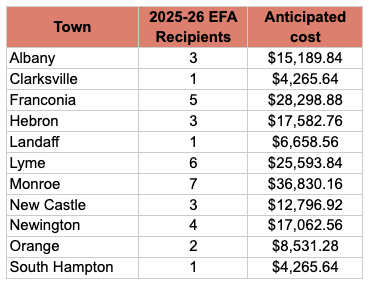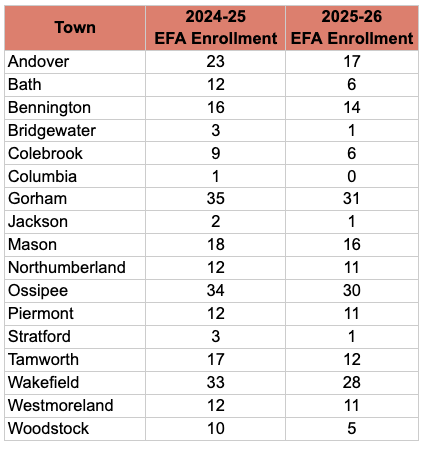Exploring early data on New Hampshire’s expanded private school voucher program
October 1st, 2025
In September, the NH Education Department (NHED) released initial data on the newly expanded Education Freedom Account Voucher program. The data do not tell us how many students switched from public schools to the voucher program or anything about where students are using their vouchers. Still, there are interesting insights to be gleaned from examining changes.
As a reminder, this is the first year that vouchers have been available to any family regardless of income. Previously, vouchers were limited to families earning below 350% of the federal poverty level, or roughly $112,000 for a family of four. This year, there were 10,000 available seats with a preference given to families eligible for free or reduced price lunch, families whose students have a special education plan, and those who had been in the program previously or had siblings in the program.
When a student switches from public school to the voucher program, the state’s contribution to their education is diverted from the local public school to the Children’s Scholarship Fund, a New York-based organization that manages New Hampshire’s EFA program. The Children’s Scholarship Fund reimburses families for eligible expenses, including private and religious school tuition, homeschooling expenses, educational supplies, transportation, tutoring, and other items. In many cases, students taking vouchers were never enrolled in public school. This results in a new cost to the state. Take, for example, a student from a family earning $200,000 a year whose parents opted for a local parochial school. Last year, without a voucher, the state would have paid nothing for that student, who had chosen to opt out of public education. This year, that family could apply for and receive a voucher, costing the state at least $4,265.
The cost to the state is determined by whether that student falls into any special categories. Every student is eligible for a base adequacy payment of $4,265.64. Students who qualify for free or reduced price lunch receive an additional $2,392.92; students with identified special education needs receive an additional $2,284.84; and students who are English language learners get an added $832.32.
How has voucher use changed this year?
Although we don’t have much information on student demographics, early data does tell us how many voucher students receive the additional payments because they are eligible for free or reduced-price lunch, qualify for special education, or are English language learners. This gives us some insight into who the program is serving.
As expected, the number of students receiving only base adequacy payments – so, those who are not English learners, do not have special education needs, and who are not from the lowest income families – grew tremendously this year, from 3,118 to approximately 7,715. (For more on why this is an approximation, see the notes on the chart.) Meanwhile, the number of students eligible for free or reduced-price lunch dropped from 2,265 to 1,498.
 Notes: English language learners are omitted from this chart because they make up less than 1% of EFA recipients. The number of students receiving no differentiated aid was calculated as the difference between total enrollment and the sum of the number of students receiving free lunch, special education, or English language learner aid. Because students may receive multiple types of differentiated aid, it is likely the count of students receiving no differentiated aid is an underestimate. Data available at this time does not tell us how many students receive multiple types of aid.
Notes: English language learners are omitted from this chart because they make up less than 1% of EFA recipients. The number of students receiving no differentiated aid was calculated as the difference between total enrollment and the sum of the number of students receiving free lunch, special education, or English language learner aid. Because students may receive multiple types of differentiated aid, it is likely the count of students receiving no differentiated aid is an underestimate. Data available at this time does not tell us how many students receive multiple types of aid.
We don’t know whether the number of free lunch-eligible students dropped because students left the voucher program or because family incomes increased, but we do know that, increasingly, the voucher program is no longer serving New Hampshire’s lowest income families.
How did voucher enrollment change in your town?
To see how voucher enrollment changed in your town, input your town name in the yellow cell below. You can add a second town to compare.
Note: Data is based on where students live, not necessarily where they attend school.
What else can we learn about voucher use?
We also explored some general questions to understand how the expanded voucher program is affecting towns and their schools.
Eleven towns that had no voucher recipients last year and have some this year.

19 towns have no EFA recipients.
Of those 19 towns, 18 had no voucher recipients this year or last year. Those towns are: Dix’s Grant, Hale’s Location, Martin’s Location, Pinkham’s Grant, Wentworth’s Location, Odell, Dixville, Cambridge, Success, Waterville Valley, Millsfield, Hart’s Location, Ellsworth, Windsor, Chatham, Groton, Easton, Pittsburg. Columbia’s voucher enrollment dropped from 1 last year to 0 this year.
In 206 out of 245 towns, the number of voucher students receiving only base adequacy aid increased.
This growth is to be expected given the changes to the program – before, many students who are only eligible for base adequacy were not eligible for vouchers because of the income restrictions. Still, the growth was especially notable in some communities. The towns with the largest percent increases in students receiving only base adequacy (so, not eligible for free or reduced price lunch or special education, and not classified as English language learners) were:

Voucher enrollment decreased in 17 towns.

What don’t we know?
Despite the release of enrollment numbers, there are still many things we don’t know. Key questions include:
-
How many students switched from public school to the private voucher program, and how many were already in the private education system?
-
Where are families spending their voucher money?
-
How long do families stay in the voucher program? If they leave, why?
-
What are the educational outcomes for students who use vouchers?
-
Why are families choosing to leave, stay at, or return to public schools?
The answers to these questions are critical in understanding the efficacy of the nearly $50 million of taxpayer money the state will spend on the voucher program this year.
Have a question? Contact us. Stay in the know and follow us on Facebook, Instagram, and LinkedIn, and join the New Hampshire Education Network (NHEN), our network of New Hampshire parents, educators, business leaders, and community members to stay up to date on the latest developments in education policy.
